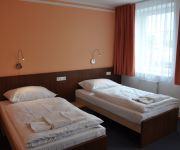Safety Score: 3,2 of 5.0 based on data from 9 authorites. Meaning please reconsider your need to travel to Czech Republic.
Travel warnings are updated daily. Source: Travel Warning Czechia. Last Update: 2024-08-13 08:21:03
Delve into Jaklovec
The district Jaklovec of Ostrava in Okres Ostrava-Město (Moravskoslezský kraj) is a subburb in Czechia about 174 mi east of Prague, the country's capital town.
If you need a hotel, we compiled a list of available hotels close to the map centre further down the page.
While being here, you might want to pay a visit to some of the following locations: Gorzyce, Krzyzanowice, Godow, Lubomia and Pszow. To further explore this place, just scroll down and browse the available info.
Local weather forecast
Todays Local Weather Conditions & Forecast: 5°C / 41 °F
| Morning Temperature | 2°C / 35 °F |
| Evening Temperature | 6°C / 43 °F |
| Night Temperature | 5°C / 42 °F |
| Chance of rainfall | 0% |
| Air Humidity | 74% |
| Air Pressure | 1012 hPa |
| Wind Speed | Fresh Breeze with 15 km/h (9 mph) from North-East |
| Cloud Conditions | Overcast clouds, covering 99% of sky |
| General Conditions | Light rain |
Monday, 18th of November 2024
7°C (44 °F)
5°C (40 °F)
Light rain, moderate breeze, broken clouds.
Tuesday, 19th of November 2024
10°C (50 °F)
7°C (45 °F)
Light rain, moderate breeze, overcast clouds.
Wednesday, 20th of November 2024
4°C (39 °F)
1°C (33 °F)
Rain and snow, moderate breeze, overcast clouds.
Hotels and Places to Stay
Jan Maria
Ruby Blue
Best Western Vista Hotel
Clarion Congress
Padre
Park Inn By Radisson Ostrava
Brioni Boutique Hotel
Mercure Ostrava Center Hotel
Imperial Hotel Ostrava
Nikolas
Videos from this area
These are videos related to the place based on their proximity to this place.
Bitka (Válka) na Bazalech ~ FC Baník Ostrava vs. AC Sparta Praha vs. Policie 22.3.2014 ~ HD
Poslední zápas FCB vs. ACS na Bazalech (od příští sezóny na městském stadióně ve Vítkovicích) a tak to jinak než takhle nemohlo ani dopadnout :-)) Vzduchem létaly nejen sedačky...
AC Sparta Praha - FC Baník Ostrava 0:1
Support Chacharů na třetím výjezdu v Praze ze čtyř utkání. Po šesti letech výhra nad ACS !!
FC Baník Ostrava - AC Sparta Praha
Video ze soboty jste již určitě viděli, ale tohle vám media jistě neukazovala, díky všem co jste přišli podpořit Baník.
FC Baník Ostrava - AC Sparta Praha 20.4.2013
Choreo a fandění z domácího utkání Baníku proti Spartě. Po delší době na Bazalech byla správná fotbalová atmosféra. Skoro 15 000 diváku z toho 570 fans ACS.
SVĚT MINIATUR. MINIUNI OSTRAVA.
V centru Ostravy, vedle areálu Výstaviště Černá louka, naleznete úplně jiný svět -- minisvět. Městečko MINIUNI nadchne děti i dospělé. Kde jinde byste měli jako na dlani 34...
Sparta Praha - Baník Ostrava, Na letenské pláni...
31. 08. 2013 - krátký záznam supportu ostravských na Letné.
Banik Ostrava - SLAVIA PRAHA; cesta a pobyt slávistů v Ostravě
Parádní sešívaný výjezd do černé džungle na velký mejdan :-) http://www.slaviaultras.cz/t/54314-Banik-Ostrava-Slavia-Praha.html Český fotbal pro fanoušky !
Run-Up Ostrava 2014 ( Běh do schodů )
Vše o akci Run Up naleznete zde http://www.run-up.cz/ Kameraman: David Bačuvčík Střih: Richard Sedláček Hudba: https://www.youtube.com/watch?v=q0BBw-ajgSM.
Videos provided by Youtube are under the copyright of their owners.
Attractions and noteworthy things
Distances are based on the centre of the city/town and sightseeing location. This list contains brief abstracts about monuments, holiday activities, national parcs, museums, organisations and more from the area as well as interesting facts about the region itself. Where available, you'll find the corresponding homepage. Otherwise the related wikipedia article.
Cathedral of the Divine Saviour
Cathedral of the Divine Saviour (Czech: Katedrála Božského Spasitele), located in the center of Ostrava, is the second largest Roman Catholic cathedral in Moravia and Silesia. This three-nave neorenaissance basilica with a semi-circular apse and two 67m high towers is dating since 1889 (building started in 1883). The church was designed by Gustav Meretta, the official architect of the Archbishop of Olomouc, and the interior by Max von Ferstel.
New Town Hall, Ostrava
The New Town Hall of Ostrava is the largest town hall complex in the Czech Republic. It is situated in the left bank of river Ostravice on Prokeš's square.
Bazaly
The Bazaly stadium is a football stadium in Ostrava, Czech Republic. It lies in Slezská Ostrava, the Silesian part of the city, next to the Ostravice River. It is the home stadium of FC Baník Ostrava. The first match was played there on 19 April 1959. The stadium was reconstructed in 2003 (added new seats, new V.I.P. rooms, cloak-rooms and press center). The cost was about 30 mil. CZK, cca. 1mil. EUR), and has had a new pitch since 2004. The capacity is 17,372 seats.
University of Ostrava
Chamber theatre Aréna
Chamber Theatre Aréna is a theatre in Ostrava, Czech Republic. Founded in 1994, it continues in the tradition of the Music Theatre (Divadlo hudby), which had existed since 1951.
Rychvald
Rychvald is a town in the Karviná District, Moravian-Silesian Region, Czech Republic, in the historical region of Cieszyn Silesia. It has a population of 6,769 (2001 census). It was first mentioned in a historical document in 1305 as Richinwalde. There is a Catholic Saint Anne Church in the town.
Lučina (river)
Lučina (Polish: Łucyna or Łuczyna) is a river in Moravian-Silesian Region, Czech Republic. It is the tributary of the Ostravice River to which it enters in Ostrava. It originates in Beskids and then flows northwestward through Horní Bludovice and Dolní Bludovice, near Havířov. Žermanice Dam is built on the river. River is distinct for its meanders which are protected as a unique natural landmark.
Vrbice (Bohumín)
Vrbice is a village in Karviná District, Moravian-Silesian Region, Czech Republic. It was a separate municipality but became administratively a part of Bohumín in 1974. It has a population of 469 (August 2009). It was first mentioned in the document of Pope Gregory IX issued for Benedictine abbey in Tyniec in 1229 as Wierzbica. Politically it belonged then to the Duchy of Opole and Racibórz, and since 1290 to the Duchy of Teschen.
Pudlov
is a village in Karviná District, Moravian-Silesian Region, Czech Republic. It was a separate municipality but became administratively a part of Bohumín in 1974. It has a population of 1,470 (August 2009). The village lies in the historical region of Cieszyn Silesia. The village was first mentioned in a written document in 1428. It was heavily influenced by the industry.
Ostrava-City District
Ostrava-City District is a district within Moravian-Silesian Region of the Czech Republic. Its capital is Ostrava.
Vratimov
Vratimov is a town in Ostrava-City District, Moravian-Silesian Region, Czech Republic. It has a population of 6,712 (2006) and lies in the historical region of Cieszyn Silesia. There is a Catholic Saint John the Baptist Church in the town.
1st International School of Ostrava
1st International School of Ostrava (1ISO) is a private, coeducational school located in Ostrava, Czech Republic. Founded in 2005 as a secondary school, it grew into an institution educating children of virtually all ages.
Roman Catholic Diocese of Ostrava-Opava
The Roman Catholic Diocese of Ostrava-Opava is a diocese located in the cities of Ostrava and Opava in the Ecclesiastical province of Olomouc in the Czech Republic.
12th Infantry Division (Poland)
Polish 12th Kresy Infantry Division, was a tactical unit of the Polish Army in the interbellum period, which was stationed in Tarnopol.
Slezská Ostrava
Slezská Ostrava (Polish: Śląska Ostrawa, lit. Silesian Ostrava), till 1919 Polnisch Ostrau (Czech: Polská Ostrava, Polish: Polska Ostrawa, lit. Polish Ostrava) is a district of the city of Ostrava, Moravian-Silesian Region in the Czech Republic. It lies in the historical region of Cieszyn Silesia, not counting Koblov and Antošovice lying north-west from the Oder river in the Hlučín Region.
Muglinov
Muglinov is a part of the city of Ostrava, Moravian-Silesian Region in the Czech Republic. Administratively it is a part of the district of Slezská Ostrava. It lies in the historical region of Těšín Silesia and was first mentioned in a written document in 1305. It witnessed heavy industrialization in the 19th century. Muglinov was formerly an independent municipality, in 1941 it became a part of Ostrava.
Hrušov (Ostrava)
Hrušov is a part of the city of Ostrava, Moravian-Silesian Region in the Czech Republic. Hrušov is historically a market town, now administratively a part of the district of Slezská Ostrava. It lies in the historical region of Těšín Silesia and was first mentioned in a border agreement between Władysław Opolski, the duke of Opole and Racibórz and Ottokar II of Bohemia, in 1256 as Grusov.
Heřmanice (Ostrava)
Heřmanice is a part of the city of Ostrava, Moravian-Silesian Region in the Czech Republic. Administratively it is a part of the district of Slezská Ostrava. It lies in the historical region of Těšín Silesia and was first mentioned in a written document in 1305 as Hermanni villa. After the heavy industrialization of Ostrava, the majority of local people were employed in nearby factories.
Michálkovice
Michálkovice is an administrative district of the city of Ostrava, Moravian-Silesian Region in the Czech Republic. It lies in the historical region of Cieszyn Silesia and was first mentioned in a written document in 1440. It witnessed heavy industrialization in the second half of the 19th century and several coal mines were dug here, most important was Michal Coal Mine. In 1907 Michálkovice gained a market town rights. Formerly an independent municipality, in 1941 it became a part of Ostrava.
Radvanice (Ostrava)
Radvanice is a part of the city of Ostrava, Moravian-Silesian Region in the Czech Republic. Administratively it is a part of the district of Radvanice a Bartovice. Radvanice was formerly an independent municipality, in 1941 it became a part of Ostrava. It lies in the historical region of Těšín Silesia and was first mentioned in a written document in 1305. It witnessed heavy industrialization at the end of the 19th century, locals worked mainly in coal mines.
Bartovice
Bartovice is a part of the city of Ostrava, Moravian-Silesian Region in the Czech Republic. Administratively it is a part of the district of Radvanice a Bartovice. Bartovice was formerly an independent municipality, in 1960 it became a part of Ostrava. It lies in the historical region of Těšín Silesia and was first mentioned in a written document in 1305 as Bertoltovice. It was influenced by heavy industrialization which occurred in Ostrava at the end of the 19th century.
Kunčice (Ostrava)
Kunčice (Polish: Kończyce Wielkie, German: Gross Kunzendorf, till 1908 known as Velké Kunčice, then as Kunčice nad Ostravicí) is a part of the city of Ostrava, Moravian-Silesian Region in the Czech Republic. Administratively it is a part of the district of Slezská Ostrava. Kunčice was formerly an independent municipality, in 1941 it became a part of Ostrava. It lies in the historical region of Cieszyn Silesia and was first mentioned in a written document in 1305 as Cuncindorf.
Kunčičky
Kunčičky (Polish: Kończyce Małe, German: Klein Kuntschitz, till 1924 known as Malé Kunčice) is a part of the city of Ostrava, Moravian-Silesian Region in the Czech Republic. Administratively it is a part of the district of Slezská Ostrava. Kunčičky was formerly an independent municipality, in 1941 it became a part of Ostrava. It lies in the historical region of Těšín Silesia and was first mentioned in a written document in 1305.
Přívoz
Přívoz (German: Prziwos, briefly till 1920 and 1939-1945 also Oderfurt) is a part of the city of Ostrava, Moravian-Silesian Region in the Czech Republic. It lies in the Moravian part of the city, in the administrative district of Moravská Ostrava a Přívoz. It lies in the historical region of Moravia and was first mentioned in a written document in 1377 as Prsiewoz. Heavy industralization that occurred in Ostrava in the second half of the 19th century also affected Přívoz.
Silesian Ostrava Castle
Silesian Ostrava Castle is a castle in Ostrava, in the northeastern Czech Republic. It was originally built in the 1280s near the confluence of the Lučina and Ostravice rivers. The castle was built for military purposes due to its proximity to the Polish border. In 1534, the gothic castle was rebuilt into a renaissance chateau. It burned down in 1872 but was rebuilt. It was restored recently after many years of dilapidation, caused by coal mining under the castle.





























